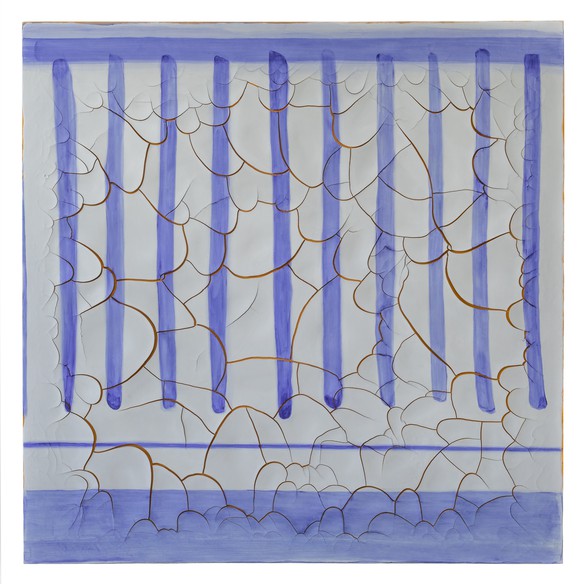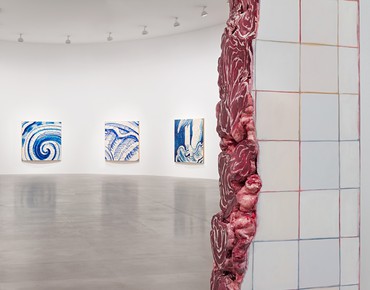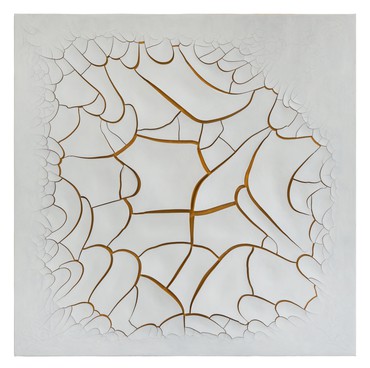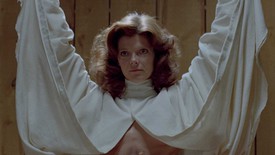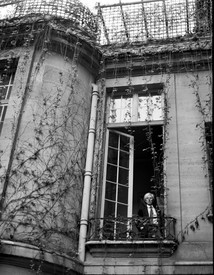
Louise Neri has been a director at Gagosien since 2006, working with artists and developing exhibitions, editorial projects, and communications across the global platform. A former editor of Parkett magazine, she has authored and edited many books and articles on contemporary art. Beyond the exhibitions she has organized for Gagosien, she cocurated the 1997 Whitney Biennial and the 1998 São Paulo Bienal, among numerous international projects.
LOUISE NERIYour Azulejão or “big tile” paintings are unique in the history of contemporary art. How did they evolve?
ADRIANA VAREJÃOFor many years, I have been deeply fascinated by the traditional blue and white tiles that decorate religious and secular historical buildings all over Portugal and Brazil. I wanted to reflect on this in my work as an artist. The tiles themselves prompted me to think about how to give my paintings an extreme physicality. I began by using thick layers of oil paint, then adding mass to the surface to simulate the quality of a ceramic tile.
LNAre there other inspirations beyond the azulejos?
AVIn studying Chinese Song pottery of the eleventh century, I became fascinated by its characteristic surface cracks and the related philosophy. It is in these cracks that Chinese writing actually originates. It was oracular; at first people tried to codify the cracks in turtle shells. This is how the first Chinese pictograms came about. An entire aesthetic evolved from reading meaning into cracks, slowly becoming its own culture.
Inspired by this, I began by using thick layers of oil paint, then I started adding mass to simulate the quality of a cracked tile, working with slow-drying plaster and experimenting over time to achieve a cracked surface.
LNIn your paintings, the cracks in a tile become something very physical, almost geological.
AVYes, I developed this elaborate process of construction to provoke incidents, mapping the passage of time.
LNHow long does it take for the surface to dry?
AVUp to one month. And I never know exactly how the surface will crack. It is fascinating, like the hand of an invisible artist at work—the same hand that makes the lines in your hand, the roots of the trees, lightning in the sky.
LNAnd then what?
AVWhen I achieve a very good cracked surface, I need to find the right image to use with it. It is in the empty spaces between these cracks where I can work with images or figures.
LNSo it’s a bit like film montage?
AVIt’s a natural order (process) in dialogue with a cultural or an artificial order (images). Two different “bodies” occupying the same space—the internal surfaces in ochre with the blue-and-white painted surface; or, in the case of my sculptures, the gridded surface that simulates tiles with the inner “flesh.”
LNAnd so once you have the ground of the painting prepared, what is the next step?
AVI have to choose the image. In my constant and ongoing research in Portugal and Brazil on azulejos, working with the same photographer over many years, Vicente de Mello, I visit churches and architectural sites, or consult repertories of tile fragments. Over fifteen years, I have amassed a vast archive of tile images. In the case of this exhibition, I chose each image for its abstract qualities. It is important to remember that, originally, each tile is a small fragment of a much larger representational scene.
LNAre the visual references of tile details that you worked from for the Rome paintings all from the same historical period and place?
AVThey range from the seventeenth century to the nineteenth century, and all of them are Portuguese.
LNPreviously, you made an analogy to music in saying that you can never interpret a single visual reference the same way twice. What did you mean by that?
AVI was speaking specifically about João Gilberto, one of Brazil’s greatest musicians and composers who almost never made any original songs; instead he recomposed existing songs in his own way, in a sort of lapidary process. In this case, the act of interpretation is also an act of composing.
From Gilberto’s example, I asked myself why should I invent new images when there are so many in the world? I don’t have to create more. My strategy is to select existing images and recreate them. And I prefer this as a way of engaging history, of finding images and picking up fragments.
LNSo there is a constant editing process at work. . .
AVYes, it’s all about the fragment.
LNMost ancient Greek philosophy survives only in fragments, as phrases or sentences. An entire philosophical universe can be generated from a single phrase.
AVThe fragment is an open structure. With the works for the Rome exhibition, the images are vital precisely because they are not complete; movement continues. In the beginning, I used to choose the fragment to build a different structure. In Celacanto Provoca Maremoto, a huge immersive installation comprising 184 paintings, I deconstructed and dislocated images in order to construct again, within the formal structure of the grid, to give rhythm to the composition.
LNThe latest Azulejão paintings are 180 centimeters squared, the largest single tile paintings that you have ever made.
AVYes, I always have to create a relation between body and space. It is clear that the viewer has to construct much more for him or herself in the empty space that surrounds these paintings.
LNWhat does this increase in scale mean for you?
AVAs in the original source—the small tile—my brushstroke has to appear spontaneous, as if I were painting quickly, with very few brushstrokes.
LNCan’t you just use bigger brushes?
AVI have tried, but it doesn’t achieve the necessary effect. Even when I appear to be working freely and gesturally, I am not. The apparent spontaneity is simulated. So my whole process and its effects are totally controlled and totally artificial.
Artwork © Adriana Varejão; Adriana Varejão: Azulejão, Gagosien Rome, October 1, 2016–January 14, 2017
